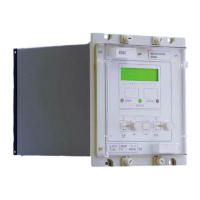VCG202/EN M/H11
Technical
Figure 3: Example connection of logic inputs
3.5.3 Analogue inputs
The relay has six analogue inputs, two on the microprocessor board and four on the
auxiliary expansion board. Each is fed via an input transducer, a low pass filter and a
three range scaling amplifier. The analogue signals are sampled eight times per cycle on
each channel as the sampling rate tracks the frequency of the input signal.
The wide setting range provided on the relay enables the relay to operate from either 1A
or 5A current transformers. The following analogue channels are utilised:
Channel Function Relay Terminals
AN0 Load Current Input 27 and 28
AN1 Tap Position Indication 19 and 20
AN2 System Voltage Input - Low Accuracy 17 and 18
AN3 External TPI supply 15 and 16
AN4 Circulating Current Input
23 & 24 for 1A or
25 & 26 for 5A
AN6 System Voltage Input - High Accuracy 17 and 18
3.5.4 Output relays
Eight programmable output relays are provided on relays. They can be arranged to
operate in response to any, or all, of the available functions by suitably setting the
OUTPUT MASKS. The control functions to which these relays respond are selectable via
the menu system of the relay.
In addition there is a watchdog relay which has one make and one break contact.
Therefore, it can indicate both healthy and failed conditions. As these contacts are
mainly used for alarm purposes, they have a lower rating than the programmable outputs.
The terminal numbers for the output relay contacts are given in the table at the start of
Chapter 3.5.
3.5.5 Setting the relay with a PC or Laptop
Connection to a personal computer (PC), or lap top, via an K-Bus/RS232 interface Type
KITZ 101 or KITZ 102 will enable settings to be changed more easily. Alternatively a KITZ
201 may be incorporated into the scheme which enables a PC or lap top to be directly
connected via the serial port mounted on the front plate. Software is available for the PC
that allow on line setting changes in a more user friendly way, with a whole column of
data being displayed instead of just single cells. Setting files can also be saved to floppy
disc and downloaded to other relays of the same type. There are also programs
available to enable settings files to be generated off-line, i.e. away from the relays that
can be later down-loaded as necessary.

